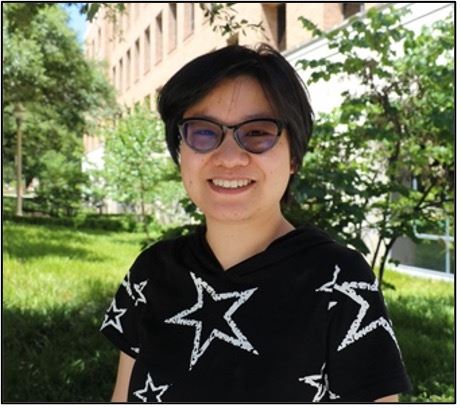

Alys Clark (University of Auckland), Sara Loo (Johns Hopkins University), Fiona R. Macfarlane (University of St Andrews), and Thomas Woolley (Cardiff University).
-
-
News – updates from:
-
People – Interviews with Prof. Ivana Bozic, the 2023 recipient of the Akira Okubo Prize, and Dr Chengyue Wu, recipient of the 2023 H.D. Landahl Mathematical Biophysics Award.
-
Editorial – We have included an overview of the SMB 2023 meeting in Ohio, from the SMB subgroups.
- Featured Figures – Highlighting the research by early career researchers Elijah Counterman and Sean Lawley, and highlighting the most downloaded paper from the Bulletin of Mathematical Biology June 2023 issue.
To see the articles in this issue, click the links at the above items.
Contributing Content
Issues of the newsletter are released four times per year in Spring, Summer, Autumn, and Winter. The newsletter serves the SMB community with news and updates, so please share it with your colleagues and contribute content to future issues.
If you have any suggestions for content or on how to improve the newsletter, please contact us at any time. We appreciate and welcome feedback and ideas from the community. The editors can be reached at newsletter@smb.org.
We have an upcoming newsletter editor position available, please get in touch if you would like more information on what is involved.
We hope you enjoy this issue of the newsletter!
Alys, Sara, Fiona, and Thomas
Editors, SMB Newsletter
News Section
By Thomas Woolley and Sara Loo

SMB Subgroups Update
Cardiovascular Modeling
The Cardiovascular Modeling subgroup would like to officially welcome its new advisory committee members Jessica Crawshaw (University of Oxford), Mitchel Colebank (UC Irvine) and Seth Weinberg (Ohio State University). Thanks to Jessica, Mitchel and Seth for helping to organise and coordinate the subgroup activities at SMB 2023!
Mathematical Epidemiology
Michael Robert (Assistant Professor, Virginia Tech) has taken over as chair with new subgroup co-chair Meredith Greer (Professor, Bates College). Michael and Meredith are looking forward to working together this year to continue the momentum built by Lauren over the past year to lead an active and engaged MEPI subgroup.
Michael Robert is an assistant professor of mathematics and faculty affiliate of the Center for Emerging, Zoonotic, and Arthropod-borne Pathogens (CeZAP) at Virginia Tech. He received his B.S. in mathematics from Mississippi State University and his PhD in Biomathematics at North Carolina State University. His research focuses on developing mathematical models to study the evolutionary, ecological, environmental, and anthropogenic processes underlying the emergence, spread, and control of vector-borne diseases. His current projects include modeling the role of climate in the ongoing emergence of dengue in Central Argentina, studying the relationships between climate and dengue spread throughout the Dominican Republic, investigating the effects of infection-altered bioamine levels on Anopheles mosquito behavior and transmission of malaria, and developing mathematical models to study how inequities may arise in the control of mosquito-borne diseases in economically heterogeneous populations. In addition to his work with the MEPI subgroup, Michael is a current co-chair of the SMB membership committee.
Meredith Greer is a Professor of Mathematics at Bates College. She has served as chair of the Mathematics Department, of the Natural Sciences and Mathematics Division, and of the Digital and Computational Studies Program (though not all at the same time!). She earned her BA in mathematics from the University of Delaware and her MS and PhD in mathematics from Vanderbilt University, with a PhD thesis focusing on prion proliferation. Since then, her projects have included the spread of H1N1 influenza and mumps on college campuses; conspiracy theory modeling; oscillation in historical smallpox data; effects of Gloeotrichia echinulata on lake eutrophication; dynamics of softball pitching; collaborations between mathematics and other courses (including rhetoric and biology) for student engagement and new understandings; and a course on precalculus-level mathematics topics motivated by scientific applications. Her current project is the development of an Open Educational Resources text on mathematical epidemiology for undergraduates.
Back to the top
People
By Fiona Macfarlane

We interviewed Prof. Ivana Bozic, the 2023 recipient of the Akira Okubo Prize, find out more here.

We interviewed Dr Chengyue Wu, recipient of the 2023 H.D. Landahl Mathematical Biophysics Award, find out more here.
Back to the top
Editorial

By Sara Loo and the SMB subgroups
An overview of the SMB 2023 meeting from the SMB subgroups
The Society’s subgroups are a key way in which members meet and interact within focused interest groups. Some of these subgroups have been established for many years, while others are just growing. They are hubs to not only bond over shared research interests and the sharing of scientific ideas, but to keep in touch, socialize and develop ongoing friendships and collaboration. Though many subgroups meet throughout the year, post to their own blogs, and send out their own newsletters, it is during the annual meeting that the value of these subgroups really shines through – not just through gathering over pizza or Mexican food, but through organizing minisymposia.
To highlight these efforts, we reached out to our subgroup committees to hear more about what they got up to during the recent SMB meeting in Ohio. These, and the rest of our SMB subgroups, can be found at the SMB subgroup page – reach out to their committee members to hear more and be added to their list of members.
Immunology and Infection:
The IMMU section had a great turnout at the 2023 annual meeting. 7 mini symposia and 3 contributed sessions covered topics ranging from viral and immune system dynamics, agent-based models, model fitting, parameter estimation, eco-evolutionary models, and more. SARS-COV-2 featured heavily this year but presentations on a dazzling diversity of systems included B cells, T cells, transplantation, Tuberculosis, Alzheimer’s Disease, HIV antibiotic resistance, Usutu virus, Equine Infectious Anemia virus, biofilms, CAR-T cells, neutrophils and more. A particular highlight was the special joint session with NIAID which featured fantastic talks and a panel from worldwide experts on modeling, data science, and collaborations between modelers and experimentalists. We hope to include more sessions like this in the future to continue to foster connection and exciting interdisciplinary science/mentorship. A big thank you to everyone who helped judge abstracts and posters!
Mathematical Neuroscience:
The SMB Mathematical Neuroscience subgroup was active at the 2023 SMB annual meeting at Ohio State University. In addition to posters and several contributed talk sessions, there were a number of mini-symposia that spanned a range of topics, including: multi-scale networks, ophthalmology, neural oscillations, dynamics, and coding. The research talks were very lively and well-attended, with very good questions and answers. The subgroup was active despite the modest representation, holding a business meeting and a social outing. One of the highlights was a social gathering on Tuesday evening (July 18) at a Mexican Restaurant. About 20 members attended, catching up with old friends and making new ones. With insights from the subgroup business meeting held during the annual meeting, we are in the process of carrying out electronic elections to determine new subgroup officers for the 2023-2025 term.
Cell and Developmental Biology:
The Cell and Developmental Biology (CDEV) Subgroup had a great time at the SMB Annual Meeting in Columbus. Our subgroup mini-symposia featured topics including data-driven modeling and topological techniques in cell and developmental biology, polarity and patterns in biochemical dynamics, stochastic effects in cell biology across scales, connections between models of pattern formation and experimental results, the role of the microenvironment in controlling cell phenotype decisions, computational models in developmental and cell biology (honoring the work of Prof. Ching-Shan Chou), and cellular biomechanics and fluid dynamics. We announced upcoming CDEV talks on our Twitter account during the conference through @SMBdevBio.
We held a CDEV business meeting during the annual meeting (and followed it with pizza at Adriatico’s, across the street from Jennings Hall). We highlighted our ongoing activities during this meeting and got great feedback on what our subgroup members would like to see from CDEV in the coming year. We’ve continued featuring interviews with scientists through our monthly blog—check out https://smb-celldevbio.github.io/blog/ to learn more. Our two most recent interviews highlight Dr. Robyn Shuttleworth from Altos Labs and Dr. Sasha Shirman from Applied BioMath. CDEV also continues to encourage folks to join the biweekly discussion group “Modeling cell development and regeneration” run by Dr. Maria Abou Chakra (more info at: https://smb-celldevbio.github.io/initiatives/). Based on the feedback that we received during the CDEV business meeting, we’re looking forward to planning a mini virtual conference on cell and developmental biology in the future, and we’re brainstorming offering mock interviews to help prepare early-career researchers for postdoc and faculty jobs.
We are grateful to the volunteers who judged CDEV posters, to the CDEV presenters and minisymposium organizers, to the participants at our CDEV business meeting, and especially to the Ohio State organizing team!
Cardiovascular Modeling:
The Cardiovascular Modelling subgroup was excited to host its inaugural mini-symposium at the SMB 2023 Annual Meeting. Consistent with the subgroup’s overall vision, the session “Integrating Mathematics Across the Cardiovascular System: A Mini-Symposium on Multilevel Modelling of Cardiovascular Biology” brought together researchers using a variety of mathematical and computational techniques to study problems across all levels of the cardiovascular system. Highlights of the session (pictured) included talks on multiscale computational modelling of hemodynamics in pulmonary hypertension (Mette Olufsen, North Carolina State University), dual lipid-structured and phenotype-structured modelling of atherosclerotic plaque formation (Keith Chambers, University of Oxford), and two-dimensional modelling of intracellular calcium dynamics in the sinoatrial node (Nicolae Moise, Ohio State University). Thanks to all the speakers for an exceptional session of talks!

DEI:
The SMB DEI Committee hosted a DEI Plenary session on mathematical modeling and the integration of diverse and underserved populations in (pre) clinical research and public health at the SMB Annual Meeting in Columbus, Ohio. Thank you to those who attended the talks by Dr. Maureiq Ojwang and Justin Sheen, and the Q&A panel that followed, consisting of the speakers as well as Dr. Renee Brady-Nicholls.
The Committee also facilitated a Diversity Lunch during the Annual Meeting. Thank you to the many SMB members who opted to sit at the DEI lunch tables and engage in meaningful conversations! If you did not have a chance to do so during the lunch (or even if you did not attend the meeting), we encourage you to check out the attached poster or slides for information about the DEI Committee's initiatives in the past years.
The DEI Committee welcomes your feedback, suggestions, and participation at this Google form: https://forms.gle/fMtPCcEQfYxsA17SA.
Mathematical Oncology:
MathOnco featured 6 minisymposia with a total of 40 talks and 34 poster presentations. Research projects reflected the exciting work occurring across many topics in mathematical oncology, including evolutionary game theory in cancer progression, dynamics of cellular heterogeneity, and state-of-the-art techniques and methods in modeling cancer treatment. We also thank Renee Brady-Nicholls for serving as a co-chair over the past 2 years, and we welcome Linh Huynh as the new incoming co-chair!
Mathematical Epidemiology:
The Mathematical Epidemiology (MEPI) subgroup was well-represented at the 2023 SMB Annual meeting with six distinct mini-symposia across 8 sessions, 4 contributed sessions, and 21 posters. Several of the MEPI mini-symposia were the product of working groups formed during the MPEI-PDEE mini-conference in February 2023 and highlighted work relevant to both subgroups. Across all talks and posters, a greater diversity of diseases when compared to recent years were represented, including malaria, dengue, COVID-19, Lyme disease, West Nile virus, avian influenza, foot-and-mouth disease, and Rift Valley fever. The role of mathematics in studying the important relationships between climate, the environment, and infectious diseases was explored in talks in the mini-symposia “Zoonotic Infectious Disease Models” and “Climate and vector-borne disease: insights from mathematical modeling,” and the importance of scale in epidemiological models was discussed in the eight talks that were part of the “Disease Dynamics Across Scales” mini-symposium. Methods for improving infectious disease models were explored in a set of two mini-symposia, including “Recent advances in parameter identifiability of mathematical models in mathematical biology” and “Integrating Data with Epidemic Models: Challenges and Opportunities.” The MEPI subgroup leadership organized one mini-symposium, “Mathematical Epidemiology: Infectious disease modeling across time, space, and scale,” and this mini-symposium highlighted the diversity of research within the MEPI subgroup as well as the diversity of researchers from numerous underrepresented groups across multiple career stages.
During the annual meeting, members of the MEPI subgroup gathered at a local brewery in Columbus to enjoy an evening of catching up after multiple years of primarily virtual interactions. This is the first social gathering of the MEPI subgroup since before 2020, and we hope to continue this tradition at all future SMB annual meetings. The MEPI subgroup would like to extend its gratitude to Lauren Childs (Associate Professor, Virginia Tech) who served as chair of the subgroup from September 2022-July 2023. Among the many accomplishments during her tenure, Lauren originated monthly news updates, led the efforts to organize and host the 2023 MEPI-PDEE mini-conference, and organized an excellent MEPI mini-symposium for the SMB 2023 Annual Meeting.
Thanks to all SMB subgroups for their ongoing commitment to engaging in our community.
Back to the top
Featured Figures
By Alys Clark
Early Career Feature - Elijah Counterman and Sean Lawley, University of Utah
In this issue, we feature Lee A Segal prize for best student paper winner Elijah Counterman, who along with Sean Lawley wrote the paper entitled “Designing drug regimens that mitigate nonadherence”. Both are at University of Utah. Here Elijah and Sean tell us more about this exciting research:

What should you do if you miss a dose of medication? Skip the missed dose and take the next scheduled dose as normal? Take an extra dose to make up for the missed dose? These questions sparked our recent work on stochastic modeling of medication nonadherence.
Medication adherence refers to the extent to which patients take medications as prescribed by their physicians. Medication nonadherence is an age-old problem, as even Hippocrates warned physicians to “keep watch also on the fault of patients which makes them lie about the taking of things prescribed.” Today in the United States, it is estimated that medication nonadherence accounts for up to 25% of hospitalizations, 50% of treatment failures, and around 125,000 deaths per year. Remarkably, the World Health Organization has claimed that improving adherence may have a far greater impact on public health than any improvement in specific medical treatments.
There are at least three major hurdles which hinder the study of medication nonadherence. First, clinical trials which force patients to miss doses of the medication being tested could be unethical. Second, nonadherence is by nature erratic, as patients do not miss doses in precise patterns. Third, there are many parameters (adherence rates, drug absorption and elimination rates, dosing intervals, etc.) to vary in any systematic investigation, and it is difficult to disentangle the individual contributions of each of these parameters. For all of these reasons, mathematical modeling and stochastic analysis is an important tool for studying and mitigating nonadherence.
The aim of our work was to use mathematical modeling to design drug regimens to mitigate deleterious effects of nonadherence. Based on our mathematical results, we proposed principles for drug regimens that are robust to nonadherence. In particular, we (i) showed the benefit of taking a double dose following a missed dose (i.e. an extra “make up dose”) if the drug absorption or elimination rate is slow compared to the dosing interval and (ii) quantified the resilience of extended release drugs to nonadherence.
Mathematically, our model took the form of the standard single compartment pharmacokinetic model with first order absorption and elimination, except that the drug intake was a stochastic process modeling the erratic missed doses of the patient (see Figure). We then used stochastic analysis to study the resulting random drug level in the body (see Figure). This mathematical analysis required generalizing a class of random variables known as infinite Bernoulli convolutions whose rather exotic probability distributions have been studied in the pure mathematics literature for many years, dating back to Paul Erdos and others in the 1930s.
You can find out more about this work here: https://link.springer.com/article/10.1007/s11538-021-00976-3
Most downloaded article in Bulletin of Mathematical Biology in June 2023
The article entitled “Forecasting Pathogen Dynamics with Bayesian Model-Averaging: Application to Xylella fastidiosa” was the most downloaded article in the June edition of the Bulletin of Mathematical Biology. This article was written by Candy Abboud, Eric Parent, Olivier Bonnefon and Samuel Soubeyrand (INRAE, France’s National Research Institute for Agriculture, Food and the Environment, Candy Abboud is now with American University of the Middle East, Kuwait). The paper addresses a Bayesian model-averaging approach to the important problem of pathogen dynamics as they enter into new territories – and the problem of predicting future pathogen invasion based on past behaviours informed by past data.

The study used spatially mapped data acquired over four years showing the presence of the Xylella fastidiosa (Xf) bacterium in Corsica (France), which has the potential to put endemic, patrimonial and ornamental plant populations at risk, as well as certain food growing industries. The data is complemented by maps of winter temperature which would impact the spread of the pathogen, but in an unknown manner. Alongside this unknown are the impacts of the location at which Xf was introduced to the region, and the timing of its introduction. A group of mechanistic candidate partial differential equation (PDE) models was used to describe Xf dynamics in the region, and the paper explored 27 scenarios: three representing the nature of growth and diffusion of Xf (homogeneous diffusion and heterogeneous growth, heterogeneous growth and diffusion, and heterogeneous diffusion and homogeneous growth), alongside 9 temperature thresholds which define a reduction in the capacity for Xf to propagate/reproduce. A Bayesian model-averaging approach was used to predict approximately two years of infection from a training set of the prior two year’s data, using the candidate PDE models. The figure shows the training data, alongside out-of-sample predictions for the testing data, the results of a number of different in-sample predictors calculated from the training data. Overall, the Bayesian model-averaging approach provided the lowest root mean square error against the training data, with a relatively large uncertainty in inference, which certainly better represents the possible variability in the future dynamics of the Xf distribution than the uncertainty generated by the other competing predictors.
You can read more about this interesting work here: https://link.springer.com/article/10.1007/s11538-023-01169-w
Back to the top
